If you live in a climate zone with relatively mild winters, such as Southern California, and you are looking to grow apples in your orchard, Anna should be your first choice. It does not have to be your only choice, but if you have to select just one, then this is the variety you will want.
Where Does Anna Come From and Why Is It So Successful?
‘Anna Apple’ trees have been around for a very long time, dating back over seven decades. The cultivar was originally developed in Israel and was commercially introduced to the United States in the 1950s.
And of course it was a big deal when that happened. Back then, it was extremely rare to find viable ‘low chill’ apple varieties. Most common apple varieties at the time required on the order of 800 to 1000 chill hours. Anna, on the other hand, could make do with under 200.
(If you are unfamiliar with chill hour requirements, you can learn more here. To keep it short, though, in order to wake up from dormancy in the the spring, blossom and then set fruit, apple trees need a minimum amount of cold winter hours, usually measured between 32 and 45 degrees Fahrenheit, or 0 to 7 degrees Celsius.)
This low chill requirement, along with its flavor and productivity, also explains why Anna still remains popular in warmer climate zones and accounts for its longevity. It still does not have much competition, at least as far as home growers are concerned.
The truth is that commercial apple production is still concentrated mostly in northern latitudes. Here in the United States, that includes the Pacific Northwest, the Midwest and Northeastern states. At least in part that is because many of the most popular apple varieties, for example Honeycrisp, still have a high chill requirement. Of course, it also helps that commercial apple growers were there to begin with and they have little incentive to move production.
Now, more recently, it has been found that even some of the apple cultivars that were previously thought to be exclusively high chill, such as Fuji, can also be grown in warm winter climates like Southern California and still set fruit. However, they do not tend to be nearly as productive and that is an important consideration for some. This means if you live in a warmer climate like USDA zone 9 or 10, you may still be able to harvest apples from such a tree, but do not expect a bumper crop. Needless to say, that may be good enough for a backyard grower, but not for a commercial enterprise. And even if you are planting for personal consumption only, then you still need to decide if you want to settle for less. This is why Anna should still be your first choice, even if it is not your only choice. If you have space for additional apple trees, you definitely should consider planting other varieties as well however.
Should You Grow Anna If You Live In a Cold Climate Zone?
So far, it may seem as though there are only good things to say about Anna apple trees. You may be wondering if it’d be okay to grow Anna in colder climate zones with very cold and long winters.
The short answer to that question is no, you should not be doing that and there are at least a couple of important reasons for that.
First of all, if your zone provides a high amount of chill hours, you will be able to grow many other apple cultivars. While Anna is flavorful, there are sweeter varieties that you may enjoy even more. For example, if you prefer a Braeburn apple with a 700-hour chill requirement, and your zone meets that threshold easily, then there is no good reason why you shouldn’t grow that cultivar instead.
Secondly, and perhaps more importantly, a low-chill apple cultivar may not perform well in your colder grow zone. This requires more explanation. It is not the cold temperature per se that is a risk factor. Anna apple trees are in fact quite cold tolerant, down to USDA hardiness zone 5, which extends to -20 degrees Fahrenheit (or -28.9 Celsius). However, given that it is low chill, Anna is also likely to awaken from dormancy and start to bloom early in the year. However, the weather can still be quite variable during that period in many colder regions. This means blossoms that emerged after a warm spell can be harmed if colder weather suddenly returns, and without blossoms you cannot get a fruit set.
Can You Grow Anna In a Hot Climate?
Anna apple trees are quite heat tolerant and can even be grown in hot desert regions such as Arizona.
As mentioned earlier, this cultivar was originally developed in Israel. In other words, it was bred to withstand Middle Eastern heat.
Obviously, the tree will require more watering in hot weather and may even benefit from a shade cloth during extreme heat waves, but the maximum temperature is not the deciding factor in this situation.
When evaluating suitability for hot climate environments, what matters ultimately is available chill hours. It’s not so much about what it’s like during the summer but more so about the winter.
Mediterranean and subtropical climate zones, which still get some cold during the winter, are fine but tropical zones are not unfortunately.
Ideally, you should be at most USDA Zone 10. If you are in Zone 11 and above, with year-round warm weather, then there is very little chance that you will accumulate enough chill hours to grow Anna apple trees.
How Productive Is Anna?
Now that we have established that productivity is a key advantage of Anna over many other apple tree cultivars, but only in warmer climates, you may we wondering just how well it performs.
The short answer is: it does extremely well. In fact, Anna apple trees tend to blossom and set fruit multiple times in a year. They also tend to be quite precocious, which means they should start to bear fruit within a couple of years after planting. (You do not have to wait 8 years, like you would with pistachios.)
If you have experience growing other fruit trees and you are reading this, this is the moment when you may have some tears of joy coming down your face. With Anna you essentially get some degree of successive ripening with just one tree.
Is Anna Self-Fruitful?
Yes, it is self-fruitful. This means you can get by with having just one Anna apple tree. You do not need a different type of cultivar nearby in order for it to set fruit.
That being said, having another type of apple tree nearby will help improve productivity for both.
Keep in mind if you introduce another apple tree for cross-pollination, then its bloom period should overlap with that of Anna. Ideally, it should be a low-chill variety as well.
The most commonly recommended options in this case are either Einsheimer or Dorsett Golden. (If you have to pick one of these two and both are available, you may prefer Dorsett Golden because it is often rated higher in terms of flavor.)
It’s worth mentioning that the 2-tree rule for improved productivity is about having two different cultivars in proximity. It won’t really help if you instead plant two Anna apple trees side by side.
What Do Anna Apples Look Like When They Are Ripe?
Anna apples are commonly described as green with a red blush when they are ready to be harvested.
If they are still completely green, you should let them linger on the tree.
The extent to which they turn red, however, ultimately depends on the amount of sun exposure.
Planted on a sunny south-facing hillside, they can even appear mostly red all around.

What Do Anna Apples Taste Like?
Anna apples are crispy and are quite sweet but it is true there is also a bit of a tartness to them.
Keep in mind the flavor also depends on the time you harvest them (and of course individual taste buds may vary).
In general, though, they tend to get sweeter, the longer you leave them on the tree.
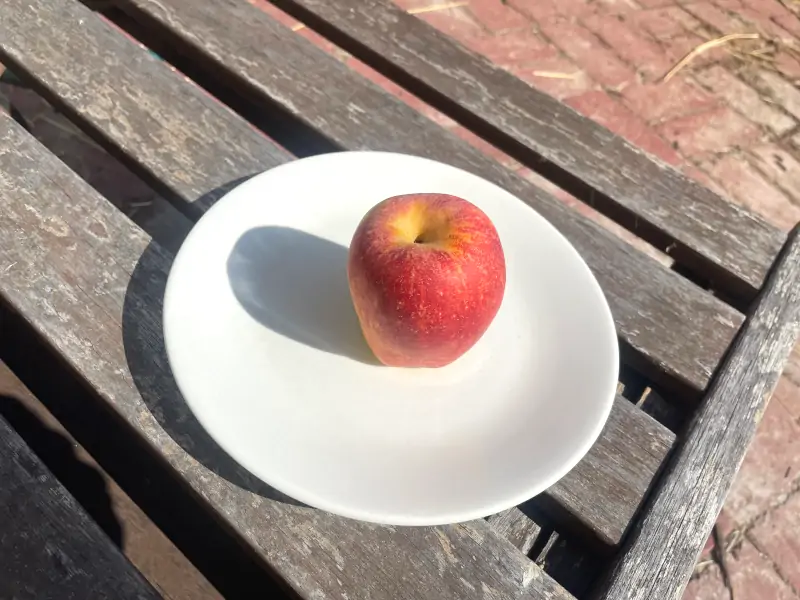
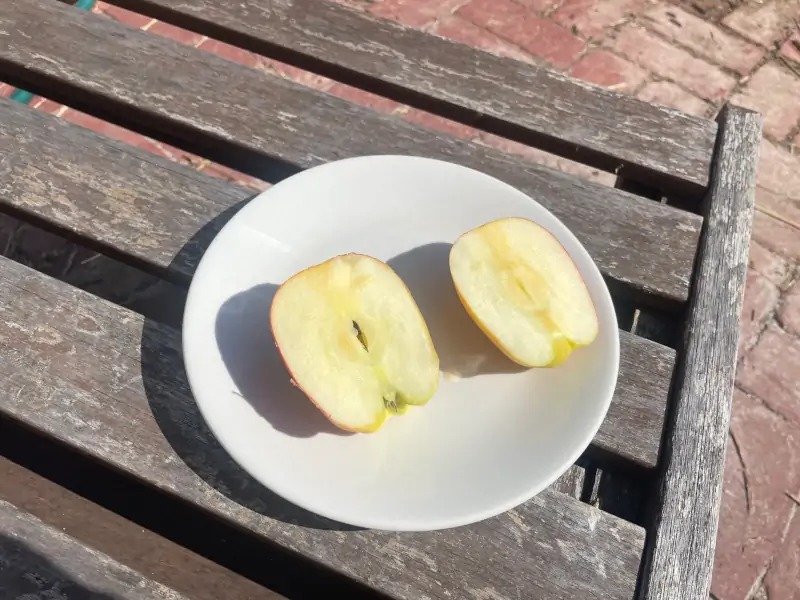
How Long Do Anna Apples Stay Fresh?
If you are growing them in your backyard, you really should only be picking your Anna apples when you are ready to eat them. They taste best when eaten fresh.
If you pick them before they are ripe, well then, that’s on you. (Don’t laugh but it’s probably a factor in some taste reviews.)
That said, sometimes life creeps up on you and you have no choice but to harvest them early. In that case, it’s not the end of the world if you leave them on the kitchen counter for a couple of weeks or so. After a week, you may notice some softening depending on how ripe they were to begin with but they will still remain edible for another week or so.
Now if you store them in the refrigerator, you can keep them even longer, up to 2 months even.
How Does Anna Apple Compare vs Other ‘Low Chill’ Apple Cultivars?
You may be wondering why we did not broach this topic earlier when we discussed competing high-chill apple cultivars.
The reason for that is we needed to go over many of the other advantages of Anna first.
It is the combination of taste, productivity and extended storage time that makes Anna superior to many other low-chill Apple cultivars.
For instance, while the Einsheimer cultivar, also developed in Israel, technically has a lower chill requirement than Anna, it is not nearly as prolific or for that matter as delicious as Anna.
What Does An Anna Apple Tree Look Like During Different Growth Stages?
The short answer is that it will look like pretty much like any other apple tree and that actually means a lot.
Anna apple trees are a beautiful sight to behold.
During the winter, they drop all or most of their leaves (you can help it along if yours doesn’t). That said, the dormancy period for Anna tends to be quite short, it could be as little as a month in a short and mild winter climate like Southern California.

The overall appearance will depend on how you prune the branches. It is common though to grow based on a central leader structure. The side branches initially point upward but over time they may become more horizontal, due to the weight of the fruit they bear.
You can expect a spectacular spring bloom of mostly white flowers, with some pink undertones. (We are calling it a spring bloom but given the low chill hour requirement, don’t be surprised if it happens in late January or early February where you live.)
Here’s a close-up of the blossoms early on.
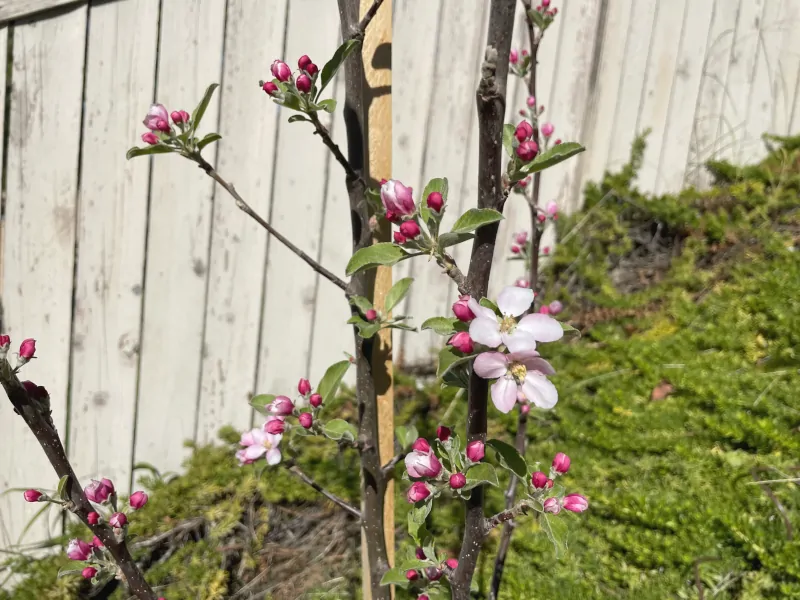
And here’s what a young tree looks like in full bloom.
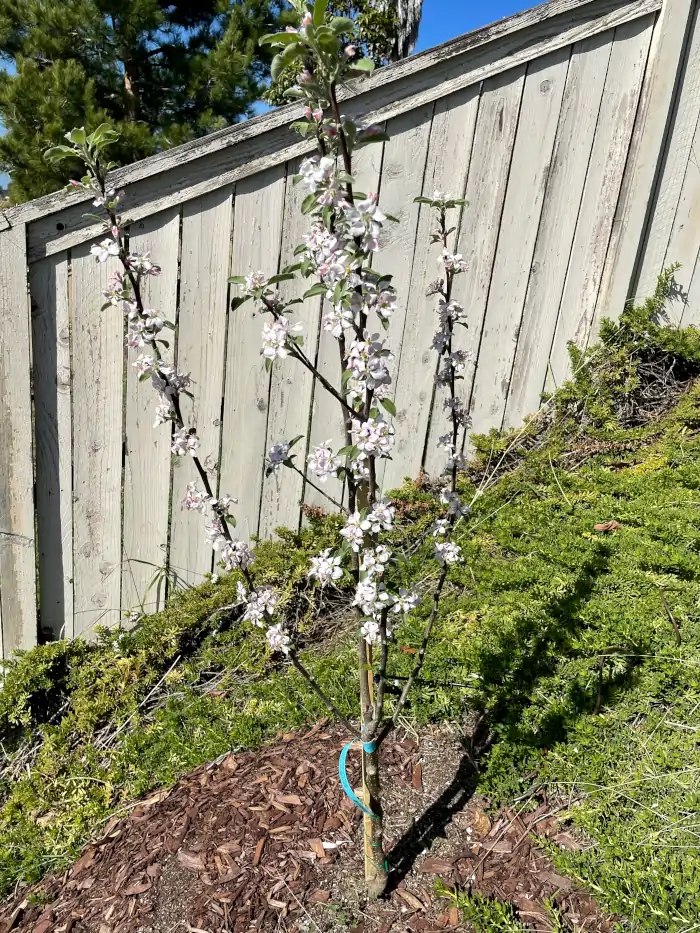
Soon after the bloom, the tree will start sprouting new leaves and thus add more green color as well.
In mid-spring you should start to see the initial fruit set on the tree. This can happen even as the tree still continues to blossom.

And this is what it looks like when an Anna apple is more developed and starts to ripen. You can see the first signs of the red blush on the apple.
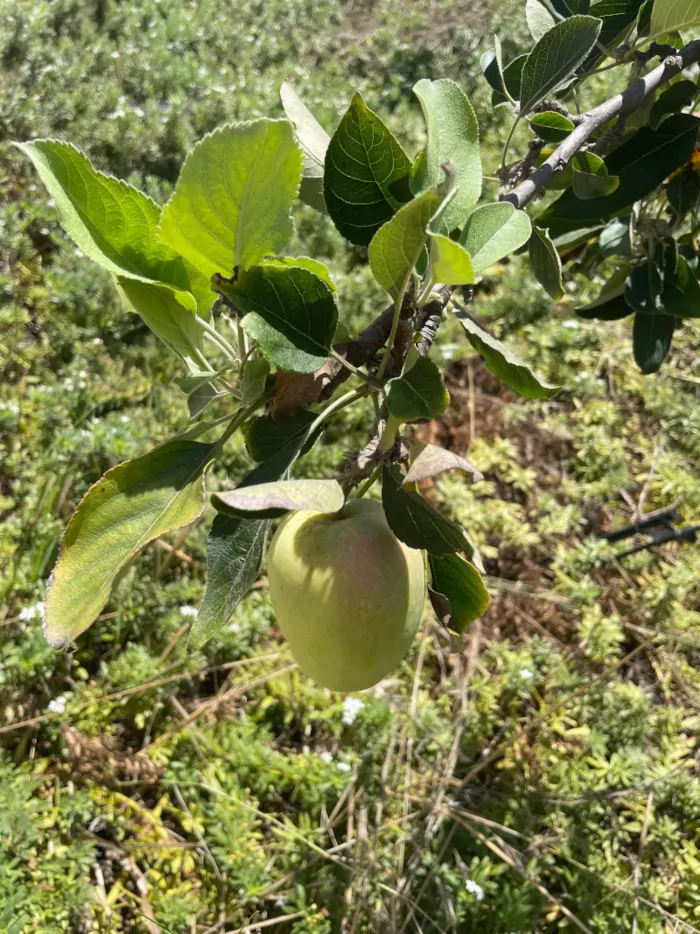
When Are Anna Apples Ready to Be Harvested?
This will depend on growing conditions but in general Anna is an early variety. In California, you should be able to harvest the main crop from late June through early August. This sets Anna apart from many other apple cultivars, especially high chill varieties, which are more likely to have harvest dates in the fall, which as you may know is the traditional season for apple harvests.
That being said, as we discussed earlier, Anna can in fact bloom multiple times throughout the year, not just in the spring, so you can still expect to harvest more fruit sets even later in the year. In fact, Anna apple tree could still be hanging on to some fruits even into winter.
Usually, apples that have more exposure to sunlight will ripen sooner so you can start by checking the outer branches of the tree. To determine if an individual Anna apple is ripe enough, you will need to assess its color and see if it has that characteristic red blush but that’s not the only factor. It should also be easy to detach from the tree branch, with minimal effort. If it takes a lot of pulling, to the point that it seems like you risk breaking the branch, then it’s not quite ready yet.
How Big Do Anna Apple Trees Get?
This is a common question with many different types of fruit trees and Anna is no exception.
A full-size Anna apple tree can grow as big as 20 to 30 feet under ideal conditions. However, it is rare for that to be the case. Ultimately, it up to you to decide how tall you want to let it grow.
If you have them in your backyard, you should be able to keep your Anna apple tree under 15 ft just by pruning them at least once a year during the dormant season.
Alternatively, you can choose to buy a semi-dwarf or dwarf version of the tree. (If you are wondering what makes them semi-dwarf or dwarf, it’s actually quite simple. The standard Anna apple tree is grafted on top of a less vigorous root stock, which keeps its ultimate size in check. Other than size, there are also some other factors to consider. Standard-size trees tend to have greater longevity, but dwarf and semi-dwarf trees tend to produce sooner, sometimes even the first year after they are planted.)
Where Can I Buy Anna Apple Trees?
We recommend buying them in store, assuming Anna apple trees are available in your area. And if you live in a warm climate, they normally are. You should be able to find them at most nurseries and even at Home Depot or Lowe’s garden centers.
If you are shopping during the winter months, that’s the ideal time you can get them because they should be available as bare root fruit trees, which means you can get a larger fruit tree for less and it will be easier and faster to get it established in your soil as well.
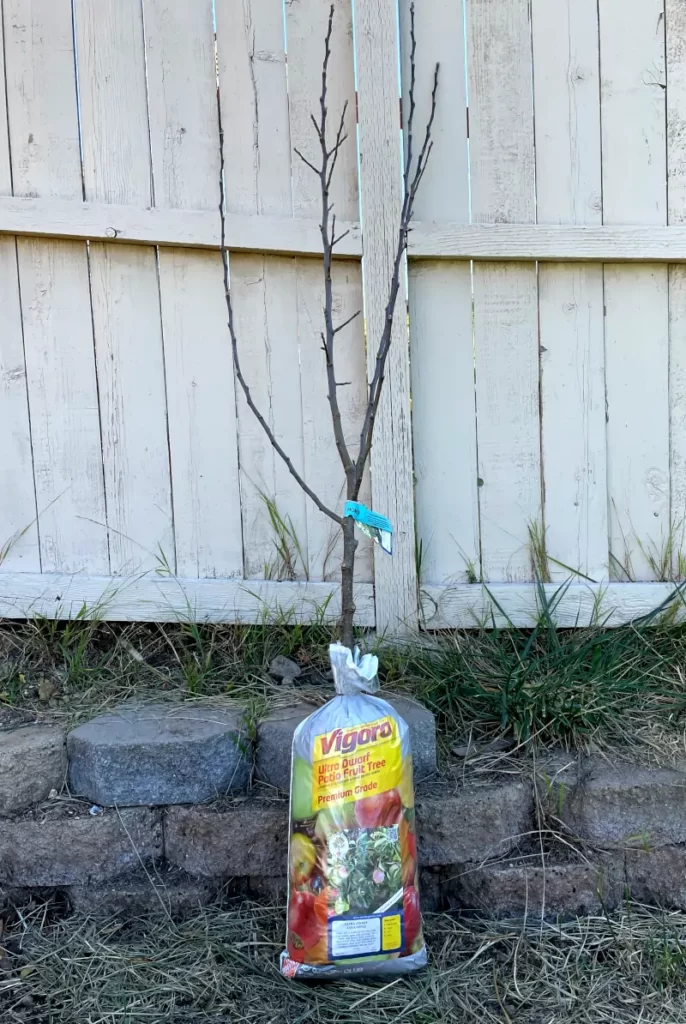
If for some reason, you are unable to find an Anna apple tree in your area, then it’s also possible to shop online and have the fruit tree delivered to you. (This article goes over buying in store vs online as well as big box stores vs. nurseries.) In this case, however, you will want to make absolutely sure that your zone is suitable for Anna apple trees. Moreover, the shipping option is more likely to be successful when the apple tree is dormant, in other words a bare root fruit tree.

![You are currently viewing Anna Apple – Profile and Review [Photos]](https://orchardculture.com/wp-content/uploads/2023/08/anna-apple-branch.webp)
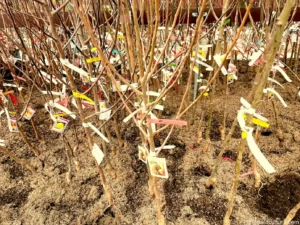

![Read more about the article Babcock Peach – Profile and Review [Photos]](https://orchardculture.com/wp-content/uploads/2023/08/peach-tree-branch-2-300x200.webp)